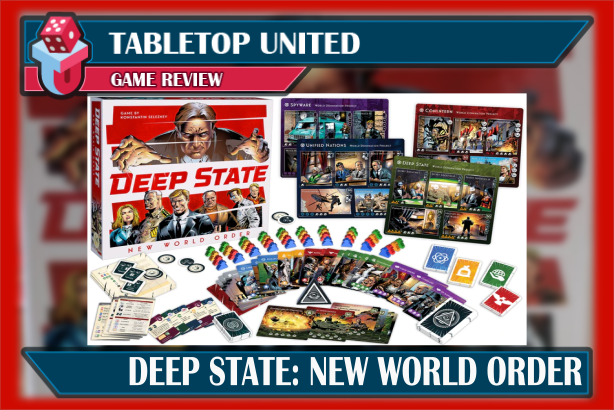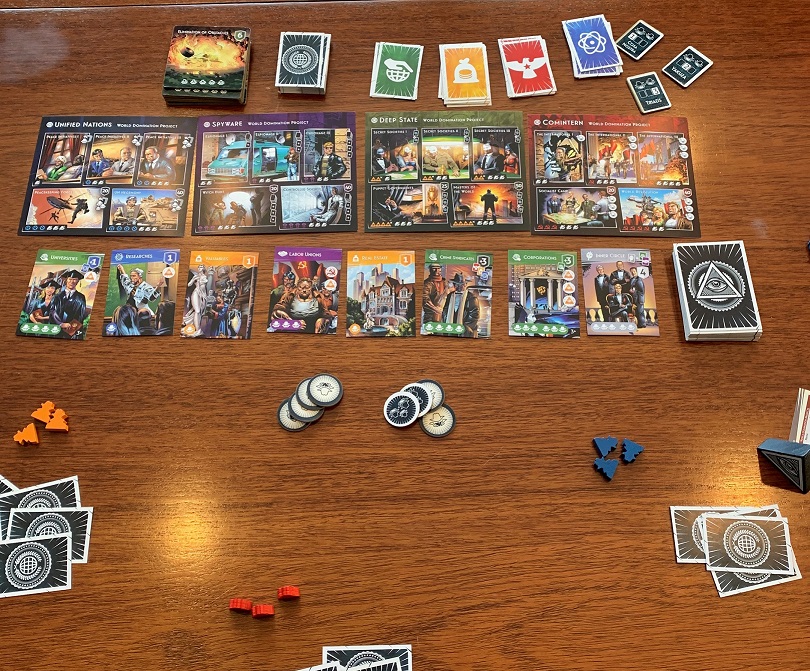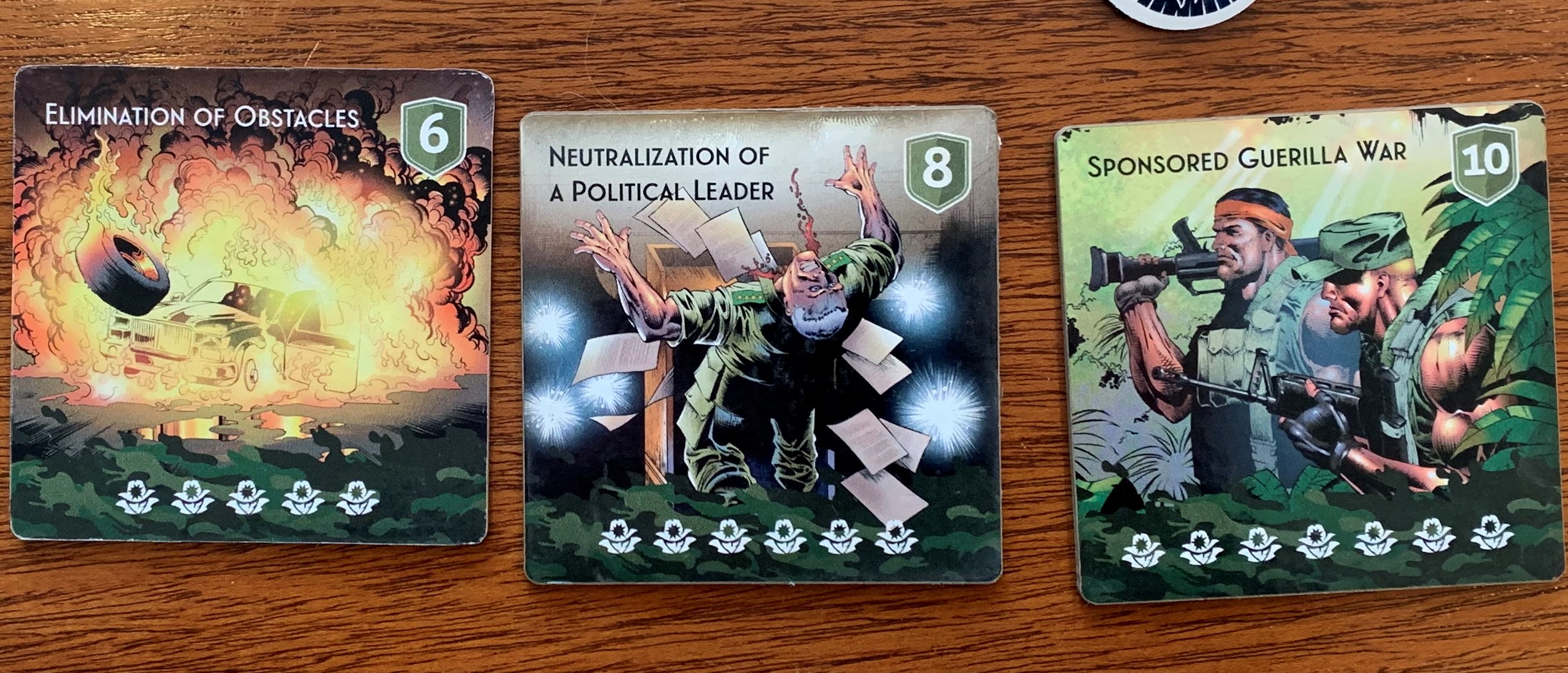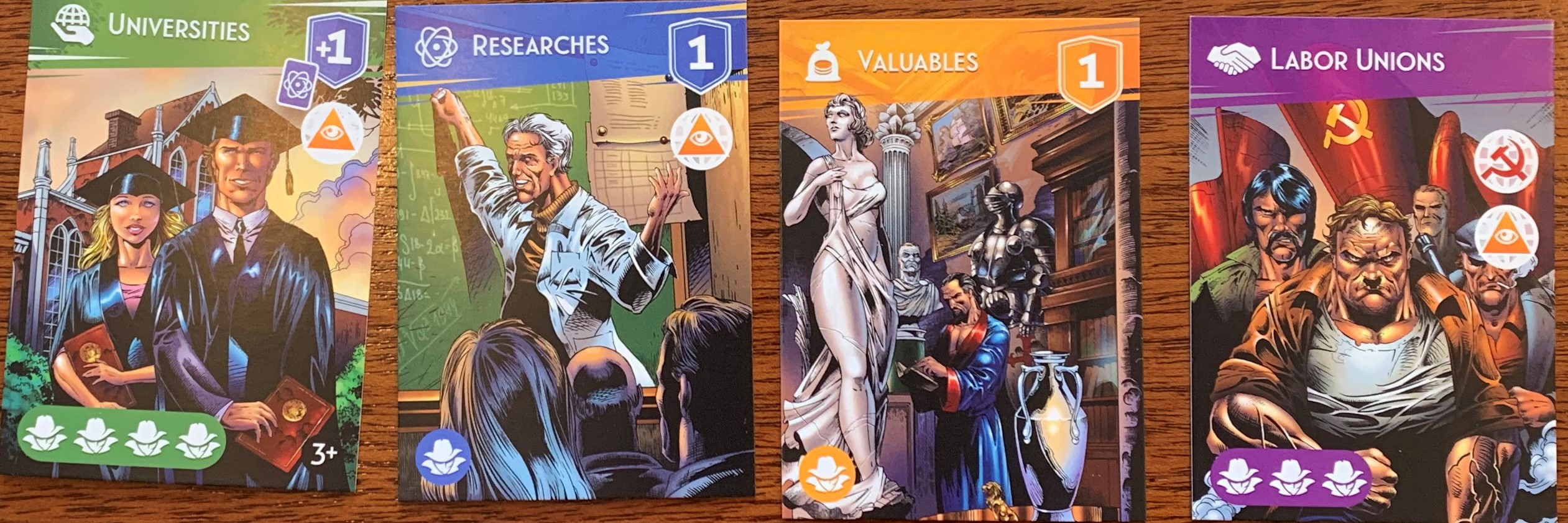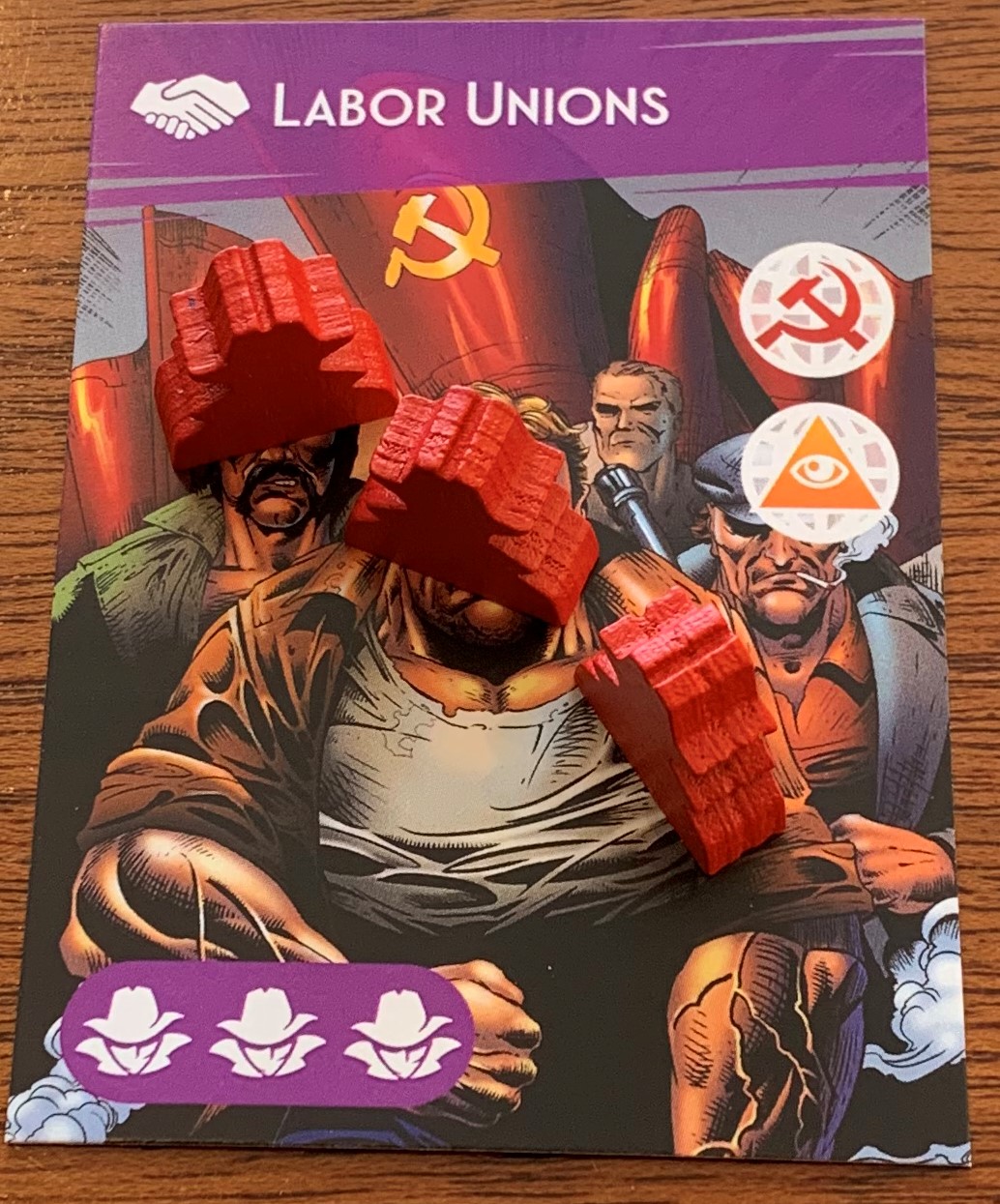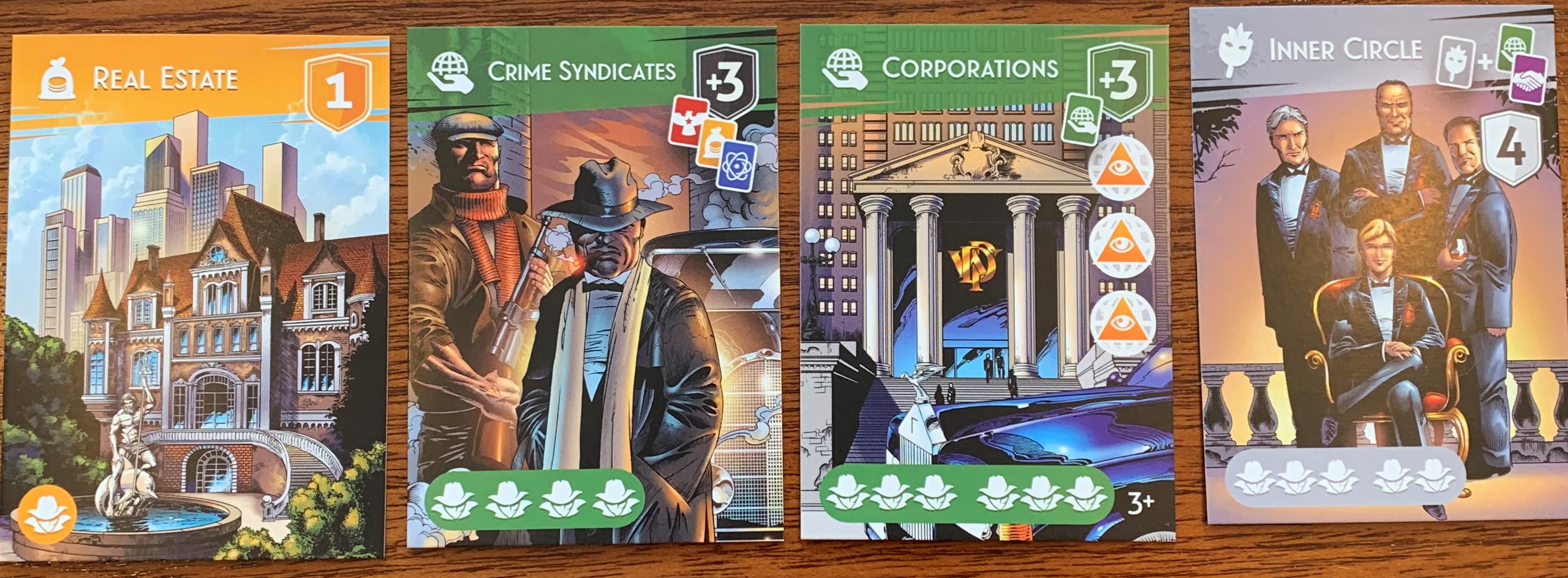Deep State: New World Order
Designer: Konstantin Seleznev
Artist: Alexander Chromov
Publisher: CrowD Games
Year Published: 2020
No. of Players: 1–5
Ages: 14+
Playing Time: 40–75 Minutes
Main mechanic / Theme: Worker Placement, Bidding / Illuminati
The world is poised for you to take control from the shadows.
Find more info on BoardGameGeek.com (link)
Overview
In a fictional history there is the Committee. A ruling body behind the governments and corporations with a basic desire to gain control, to gain power. There are distinct individuals who are working towards that goal, for the Committee and for themselves. Conspiring, manipulating, using every level of strategy to place themselves at such a level of influence that they are the one in control.
Deep State: New World Order is a strategy game of gaining influence through different options and multiple levels of strategy. Three of us sat down to play and found the game was easy to learn, even with a 24-page rule book and 16-page reference guide. The strategy, on the other hand will take longer.
We had fun. The complexity of the strategy kept everyone engaged, second guessing, and having the moment of enjoyment when a particular synergy was uncovered. We only played with the basic game and did not use the Men of Action Expansion that is included. The developers recommend not using the expansion until you are more familiar with the game, and I agree. There is enough going on to keep you working on your game through several times playing.
Gameplay and mechanics
Deep State uses several mechanics during the game. They are combined nicely to provide different options and create lines of strategy that keep you thinking and watching what can be done, or what is available. Sometimes the mechanics of how the round unfolds forces you to take a particular action you may not really want to take. The game has set that if you can take an action, you must.
During the game players have different options depending on their position during their turn in the round. Rounds have three phases of play.
1: Action Phase
This is when the players use their agents.
The first player (the one with the Supervisor) first recruits two agents from their reserve. Then they can either Infiltrate an Objective Card (placing a number of agents on the card that is equal to or greater than the required amount because following players can over bid your action on Objectives) or carry out a Covert Operation. This limitation becomes important later in the round as things become limited.
The next player now takes their action. They do not automatically recruit two agents, which is reserved for the player with the Supervisor; however, they have more actions to choose from. Along with the Objectives and Covert Operations they can also to choose to advance a Project of recruit an agent.
After they have taken their action this continues until each player has taken an action.
2: Takeover Phase
Players move the Objective and Covert Operations they gained in front of them, all of the agents are still on the cards.
Now they can Recall Agents. For Objectives, one agent from the captured objective, or from previous rounds, has one agent moved back to the active pool. They rest remain for later recall, unless you have advanced in the appropriate World Domination Project which allows you to bring back additional agents.
For Covert operations, one agent is also moved back to the active agent pool, the rest are moved back into the reserves as casualties lost. They can be recruited later.
Now the board is checked to see how the next round is played.
If one or more cards remain in the Objectives row of face up cards, the Supervisor moves to the next player and another round of action is started. This means that a single round of cards can last different lengths of time depending on how players go after the Objectives versus the Covert Operations and the Projects.
If there are no more cards in the Objective line, you have a Treaty Phase.
Treaty Phase
Each player can play one treaty from the treaty cards they have in their hand if the requirements of making the treaty are met. After playing a treaty the player discards any extra cards out of their hand down to six for the next round of play.
After each player has had the chance to play a Treaty you create a new Objectives line and start a new round.
If there are not enough cards left in the deck to create a full line, then the game moves into scoring to see who won.
After the first round the objectives may include one or both of the World War Cards. These cards change the requirements of the remaining Objectives and Projects. We found these times are important because there are Projects that can only be completed during a time of war.
Theme
The theme of an illuminati style committee controlling the world from the shadows is a great place to start for. Each player has to consider what they need to implement Treaties, advance Projects, and keep an adequate pool of active and ghost Agents. Sometimes the best play was definitely to block a player who hadn’t taken an action yet, or who would gain two more agents if it went into the next Action Phase.
Artwork and Illustration, Graphic Design and Layout
The components are well made. The cards were a lighter weight card, but that shouldn’t be much of a problem for greater play because you don’t need to constantly handle them or hold them in your hand. Most of the active playing is with the meeple agents.
The art kept the concept of the Dark government throughout. The premise is everything is taking place in an alternate history of the 20th century and the art reflects the period of the Cold War. The artist is Aleksander Khromov.
Final thoughts
I brought in a couple of players who I know like strategy games after I read the rules. The three of us enjoyed the complexity that Deep State presented. It allowed us to be working our own hands, but also needing to watch what the other two were doing.
We played the basic rules for Deep State and everyone agreed the optional rules concerning treaty selection (deal six keep four) and the additional Men of Action Cards are things we can look forward to playing.
The Reference Guide was nice to keep on hand for quick explanations. Both it and the Rules book were well done for easy understanding (we do play a lot of strategy games with complex rule sets, so that helps.
Players who like complexity in strategy, requiring flexibility in your plan, will enjoy the Deep State.
About the Author
Daniel Yocom does geeky things at night because his day job won't let him. This dates back to the 1960s through games, books, movies, and stranger things better shared in small groups. He's written hundreds of articles about these topics for his own blog, other websites, and magazines after extensive research along with short stories. His research includes attending conventions, sharing on panels and presentations, and road-tripping with his wife. Join him at guildmastergaming.blogspot.com.
